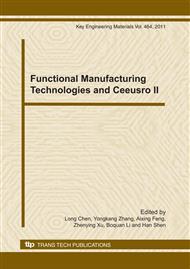p.374
p.379
p.383
p.387
p.391
p.395
p.401
p.405
p.409
Study on the Improvement of Fatigue Crack Growth Performance of 6061-T6 Aluminum Alloy Subject to Laser Shot Peening
Abstract:
In order to enhance mechanical property and restrain crack growth of 6061-T6 aluminum alloy, laser shot peening (LSP) was employed to induce compressive residual stress and plastic deformation on the surface of metal. The FEA code ABAQUS and MSC. Fatigue were used to simulate crack growth of Compact tension (CT) specimens treated by LSP. The numerical simulation results showed that LSP can effectively inhibit the crack growth, decrease the crack growth rate as well as increase the final crack size, and as a consequence, fatigue life was extended. Adding peening times could get deeper compressive residual stress field which strengthen material surface and restrain crack growth, but the fatigue stress intensity factor threshold decreases.
Info:
Periodical:
Pages:
391-394
Citation:
Online since:
January 2011
Authors:
Price:
Сopyright:
© 2011 Trans Tech Publications Ltd. All Rights Reserved
Share:
Citation:


